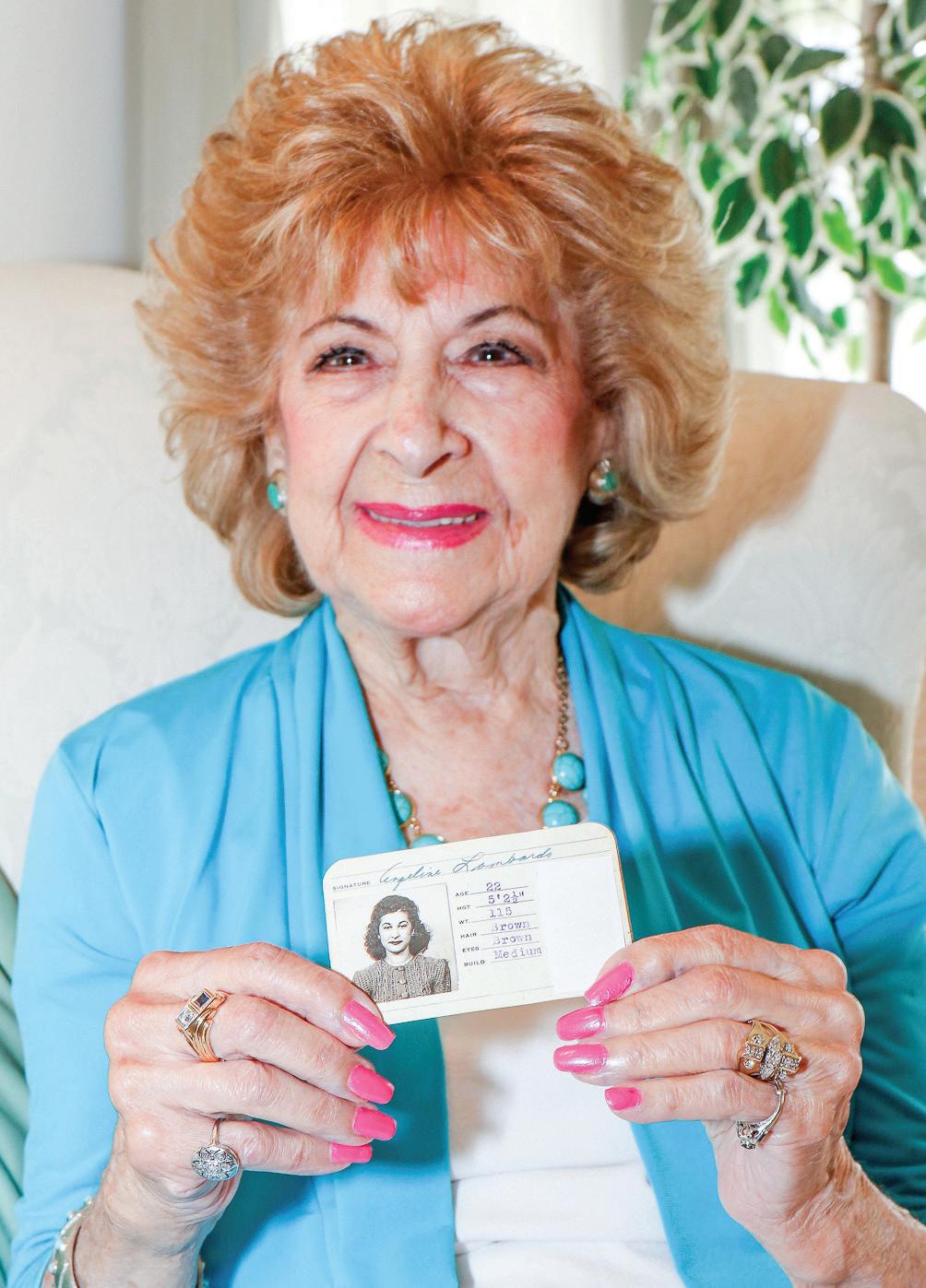NEWSPAPERS Special Edition







JULY 10, 2024
candgnews.com
Macomb County and Grosse Pointe papers










JULY 10, 2024
candgnews.com
Macomb County and Grosse Pointe papers


BY KARA SZYMANSKI kszymanski@candgnews.com
SHELBY TOWNSHIP — As Michigan Central Station celebrated its reopening after many years and an extensive renovation project, a longtime resident of Shelby Township shared her memories of when she worked at the Michigan Central Station in the 1940s.
Angela Spalla and her daughter, Liana Spalla, of West Bloomfield, reminisce about when Angela worked at Michigan Central Station and how much it has changed since then. Angela has lived in the same house in Shelby Township since 1958 and is now 103 years old.
She worked at Michigan Central Station from 1943 to 1946 before she got married to her fiancé, Frederick Spalla, who was a Marine sergeant stationed in the Philippines during World War II and who was honorably discharged prior to the end of the war because he suffered a disease from an insect bite. Angela worked as a clerk in payroll in the accounting department at Michigan Central Station. She still has her picture identification and free train pass. She said she loved her job at Michigan Central Station. With her own savings, Angela purchased the family’s first Bell telephone and the desk to set it on.
“She worked on the first floor and could see the arrivals off the train, and she had to use her math skills to calculate payroll accounts for the employees, but when she had some fraction problems, she would ask one of the guys close by to help her solve the problem. Soon before she left her job, she was being trained to use the calculator, which was a little difficult at first, but then she liked it,” Liana said.
Angela said she was glad she got to learn how to use the calculator for the future.
She said that especially during the war years, there were mostly women, young and old, some younger men but more older men — middle aged — who worked at the station. Many military personnel arrived at the station, including Angela’s fiancé.



BY NICK POWERS npowers@candgnews.com
CLINTON TOWNSHIP — FAN is still FAN, but the letters have a different meaning.
Families Against Narcotics has changed its name to Face Addiction Now. The switch reflects the nonprofit’s
expanded services since it started in 2007.
FAN co-founder Linda Davis, a former 41B District Court judge, spoke about the rebranding at the ribboncutting for the nonprofit’s new offices on June 17.
“When we started, we were angry families who wanted to stop narcotics,” Davis said of the name change. “We’ve grown beyond that name. We work with hospi-
tals, police departments, almost everybody in the community and we help everybody face addiction now.”
Davis helped found the nonprofit following a family member’s struggle with addiction. She said this story had a happy ending, but that many similar stories do not.
See FAN on page 10A
























































BY K. MICHELLE MORAN kmoran@candgnews.com
DETROIT — Students at schools in the Grosse Pointes are once again getting a chance to showcase their artistic skills at the Detroit Institute of Arts.
The third annual Wayne County High School Art Exhibition opened June 21 and will be on view until July 21 at the DIA. Of more than 200 submissions from students at 70 high schools across the county, 81 works were chosen for the exhibition — 15 of which came from students who attend schools in the Pointes.
“This exhibition is getting better every year,” DIA Director Salvador Salort-Pons said while addressing students and their families at the opening. “It really is an honor to welcome all of you here… We are committed to fostering artistic expression and providing a platform for young artists to show their work.”

DIA educators went through the submissions to select which ones would be part of the exhibition.
“Our jury panel had very difficult deci-

BY MARIA ALLARD allard@candgnews.com
MACOMB COUNTY/CENTER LINE — Several Center Line High School students are doing what they can to help their peers who might be struggling with mental health issues.
The Macomb County Health Department and psychology students from the high school’s Health and Human Services Academy recently completed a collaborative project in which the students developed posters with messages that promote positive behavioral health.
The psychology students worked in class to create adolescent-focused behavioral health images designed to encourage youth to seek help with mental health concerns or substance use. More than 25 projects were submitted, and the four Center Line High School projects were selected to be published in print and social media.
The four posters chosen were: “Speak Up,” by Samiat Hasan; “54Y 50METHING,” by Arienna Young and Miles Waugh; “7:45 Nevaeh,” by Jaclyn Kupraszewicz; and “Don’t Smoke Your Fruits,” by Nik Ferrin and Trent Zielinski.
The poster project aligns with Healthy Macomb’s recently published 2024-2028 Community Health Improvement Plan in which behavioral health was identified as a priority area. Healthy Macomb is a partnership between the Macomb County Health Department and more than 25 organizations, agencies, and community members dedicated to identifying and creating solutions that address health concerns in Macomb County. A main component for the plan is a community health assessment which identifies the most prevalent health issues among community members.
“Our assessment was able to capture the voices
See POSTERS on page 5A
TOP LEFT: “54Y 50METHING” was by Arienna Young and Miles Waugh. TOP RIGHT: “Speak Up” was by Samiat Hasan.
BOTTOM LEFT: Jaclyn Kupraszewicz designed the poster “7:45 Nevaeh.”
BOTTOM RIGHT: “Don’t Smoke Your Fruits” was by Nik Ferrin and Trent Zielinski.































































































































































She said her fiancé would arrive at the station when he was on a furlough to come home to Detroit, and there were many servicemen arriving at the station. Angela said she got to see a couple of movie stars while working there and thought it was really cool. She met a few celebrities in person and asked for their autographs.
“While working, I would see celebrities coming and going on the trains,” Angela said.
Liana said that when the employees heard a celebrity was coming into the station, they would run down to the tracks to see the celebrity.
“She remembers seeing Loretta Young, to whom she told was beautiful, and Loretta Young thanked her. Bob Hope signed his autograph and was very nice. Victor Mature got off the train but wouldn’t sign his autograph or even look at her — he just walked away. She remembers one time she and a group of her co-workers were asked if they
from page 4A
of more than 6,500 adults through surveys and outreach activities to gather input from county residents,” said Maria Swiatkowski, division director for community health planning and promotion at the Macomb County Health Department, in a prepared statement. “However, youth have historically been underrepresented in the assessment and engagement process. In our 2023 assessment

Editors: Brian Louwers | (586) 498-1089 | brianlouwers@candgnews.com
Annie Bates | (586) 498-1071 | abates@candgnews.com
David Wallace | (586) 498-1053 | dwallace@candgnews.com
Sports: Jonathan Szczepaniak | (586) 498-1090 | sports@candgnews.com
Artroom: (586) 498-1036 | ads@candgnews.com
Classifieds: For ad rates (586) 498-8100
wanted to take the train somewhere — they wanted to go somewhere to have lunch, so they went to Indiana,” she said.
Angela also helped one of her five sisters to secure a job at the station in a different department.
Angela said that after quite a while, the building was abandoned and just sat there. The station closed in 1988.
“It just sat there for years until Ford bought it out and made it into the most beautiful building you’d want to see, and the inside is absolutely gorgeous. They put in these beautiful chandeliers and architecture work that is just gorgeous. You really have to see it,” she said.
Angela has become a celebrity in her own right since the Michigan Central Station’s reopening.
She was featured in the grand opening exhibit at Michigan Central Station, and multiple local television networks have interviewed her.
While Angela was by her photo at the grand opening, she said, people were saying, “That’s her,” and asking for her autograph. She said she really enjoyed that after all these years.
cycle we were able to escalate the involvement of youth, and concerns about mental health was a common theme. Getting students involved in the design and development of behavioral health messages allows them to be a part of positive change we are looking to promote through the Community Health Improvement Plan.”
For more information on Healthy Macomb and the Community Health Improvement Plan workgroups, visit macombgov. org and click on the Health and Community Services page.


Bozimowski | (586) 498-1032 | kboz@candgnews.com Legals and Obits: (586) 498-1099
Automotive Advertising: Louise Millar | (586) 498-1054 | lmillar@candgnews.com
Estate Advertising: Paula Kaspor | (586) 498-1055 | pkaspor@candgnews.com


sions to make,” DIA Community Engagement Programs Manager Ani Garabedian said.
Miles Fradeneck, of Grosse Pointe Park, a Grosse Pointe South High School senior who just graduated, said he created the graphite and charcoal drawing, “Marlboro Man,” for an Advanced Placement portfolio “about how us as a society view cowboys as hypermasculine.” Fradeneck’s series explores how real cowboys included many Black and indigenous people, as well as gay individuals who were fleeing persecution and discrimination.
“A lot of Hollywood movies were based on stories about Black cowboys, but they were whitewashed,” Fradeneck said.
Jack Webber, of Grosse Pointe Farms, another South senior who graduated in June, made the highly detailed large-scale drawing, “USS MacArthur Aircraft Carrier.” He said he created the drawing — which shows the inner workings and parts of a massive ship — on separate, smaller pieces of paper that he then taped together, working on it in class when he was done with his other work.
“I’ve not really taken any (art) since middle school,” said Webber, who will be studying nuclear engineering at Penn State University this fall.
South junior Felix Grousta’s digital and mixed media work, “Connected,” was chosen for the show. Grousta, of Grosse Pointe Park, used a photo of a friend as the basis for the piece, which the artist said was “definitely very experimental” and has a textural appearance.
Grousta’s mother, Chelsea Grousta, credited the teachers at South for helping their students reach their creative potential.
“They’re so good at what they do,” Chelsea Grousta said.
Wayne County Executive Warren Evans said that art is important to the vitality of the county. He thanked parents and teachers for supporting and nurturing the young artists in their lives.
“There’s been some great work (in the show), and the motivation to do that work comes from teachers and family,” Evans said.
Two pieces of raku pottery by South senior Rei Schoenberg, of Detroit, are on view: “Vince’s Corduroy” and “Deco-Rei.”
“I just started doing ceramics this school year,” said Schoenberg, who hopes to attend the College for Creative Studies in Detroit this fall.
Before that, she said she focused on metals and welding. While Schoenberg’s pieces at the DIA don’t reflect this, the artist said she tries to incorporate other media — especially metals — into her ceramics, and she has also welded elements to pots.
“The style I go for is industrial — trying to make things look like they came from Detroit,” Schoenberg said.
South senior Cassidy Woolums, of Grosse Pointe Park, spent roughly 200 to 300 hours, and about 150 layers of paper, to make the mixed media work, “Dumpster Fire,” for which she used scrap paper, cardboard and colored pencil. The elaborate, layered work is best appreciated in person to see the dimension and detail.
“I was playing around with working with textures and perspective,” Woolums said of “Dumpster Fire,” which started with a photo she had taken of a cluster of newspaper boxes downtown. Woolums then


drew the boxes freehand, along with other images in her piece.
“The way things degrade and fall apart is kind of artistic in a way,” Woolums said.
She said she plans to study mechanical engineering this fall in college but hopes to continue her art as well.
“There’s a lot of good pieces from Grosse Pointe,” Woolums said. “The whole exhibit is amazing.”
While works were accepted from students in any high school grade level, the majority of the pieces chosen were from juniors and seniors. One of the exceptions to that was South sophomore Anna Burlaka, of Grosse Pointe Farms, whose digital photo, “Contemplations,” was shot in her neighborhood. She said she drew her influence from photographer Gregory Crewdson.
“He takes cinematic, surreal photos of psychologically themed subjects, so I
emulated him,” Burlaka said. “I try to make something that people can connect with.”
Other South students with work in the show include senior Brody Yeloushan, senior Jacqueline Verhaeghe and junior Lauren Winiarski.
University Liggett School in Grosse Pointe Woods had several students with work chosen as well: senior Leyao Zeng, senior Kelsey Beckett, senior Sana’a Brown and junior Lydia Fedewa Widick.
Evans said the county is looking at ways to possibly expand this exhibition and take it to other venues.
“We think it’s important that people see it,” Evans said.
The DIA is located at 5200 Woodward Ave.. Admission to the student art exhibition is free for residents of Wayne, Oakland and Macomb counties. For more information, call (313) 833-7900 or visit dia.org.

BY DEAN VAGLIA dvaglia@candgnews.com
MOUNT CLEMENS — It is Friday, May 17, and Lois Lombardo is in the fight of her life.
The owner of Olympia Salon & Spa on Cass Avenue is trying to work her new water pump in a shed on the other side of the city, but nothing is going right. She flips switches, turns valves and repositions a hose in hope of getting the pump to send its water to the surface.
Suddenly, a breakthrough: The pump roars to life and bathes Lombardo and the rest of the shed with dirt-brown water stinking of rotten eggs, a scent that hangs in the air for the next hour. From the senses alone, it is hard to believe anyone could find value in extracting such a liquid, but Lombardo knows what she has. It is the reason she came to Mount Clemens, and it is the key to how she plans to revive the century-old industry that put Mount Clemens on the map.
Welcome to Bath City
Mount Clemens is known as Bath City, or at least it is to its residents. Anyone trying to hunt down the signs of a citywide bathing industry have to look hard to find anything beyond baked-in echoes to verify this odd claim to fame, and even then, all they have to work with is a preserved pump in Clemens Park and a historical marker on the east side of Select Specialty Hospital. For something that the city clings to as its identity, the lacking modern footprint of the bath industry almost seems inscrutable. But in some ways, it is fitting that an industry that began as a boom would leave so little behind.
In the 1870s, speculators came to Mount Clemens on the hunt for oil. Their drills found murky liquid beneath the city, but not the sweet crude they hoped for.
“We did not have oil, but we did have some amazing mineral water that had so many different minerals in it,” said Beverly Bishop, a Crocker House Museum docent.
The Original was opened in 1873 by physician Henry Taylor, who capitalized on the interest kicked off by local flour mill owner Dor Kellogg, who attributed his cured eczema to bathing in the water in 1870, and by physician Abner Hayward, who prescribed baths to patients with rheumatism. As word spread of the city’s healing waters, more bathhouses sprung up and more people came seeking treatment. With recommendations calling for people to regularly bathe in


the waters, guests would book nearly monthlong stays in local hotels, prompting the creation of a hospitality industry featuring restaurants, big bands, symphonies, theaters and other things to keep the guests entertained throughout their stay.
And if the idea of a month-long hotel stay featuring daily spa visits and regular entertainment sounds expensive, that is because it was. Bishop says it cost 75 cents to take a bath in 1913, or about $24 when adjusted for inflation. Add in the costs of the hotel stays and nightly shows and the ideal Bath City visit begins to snowball into an expensive endeavor.
“It was kind of ritzy, and you had to have a whole 21 days of vacation time,” Bishop said. “So I would say it would have been a higher class (activity), but anybody
could sign up for it.”
Key to the rise of the bath houses was the city’s rail connection and proximity to Detroit. That allowed Mount Clemens to capitalize on the resource and gain the clientele and popularity that eluded other communities with mineral water springs that were simply too remote.
“We were lucky because there were trains that came from New York City across to Detroit and then we had spurs that went straight up to Mount Clemens,” Bishop said. “Thomas Edison was really one of the first people working that spur in 1859 and it was like a hub just above Detroit, and much nicer than Detroit was at the time … Midland tried to do that, but nobody could get there because there were no trains. They had to go overland by buggy and there were no roads for cars when they came in, so Midland went the pharmaceutical route and Dow Chemical ended up using the mineral water for their purposes.”
An exact count of how many bathhouses existed is hard to determine. The nature of the industry meant many of the houses would pop up and go out of business fairly quickly with the only solid evidence
— Source: Mount Clemens 175th anniversary pamphlet, published by the city in 1993 and provided by the Crocker House Museum & Gardens
of a bath’s existence being advertisements and whichever ledgers and letters have been preserved from over 100 years ago. A 1993 pamphlet about the industry printed for the 175th Mount Clemens anniversary places 11 baths within the city’s limits, including the Saint Joseph Sanitarium, now known as Select Specialty Hospital.
Ownership of bath houses was fairly diverse, with Black resident George Hutchinson opening the Eureka on Welts Street near Clemens Park, a decision believed to be attributed to a 1905 news story about a Black university graduate being refused service by the city’s baths. Julia Miller Thome operated the Monroe Hotel and Plaza Bath House after her brother, Fred, died in 1923. Throughout the 1910s and 1920s, several Jewish New Yorkers made the trip to Mount Clemens, took ownership of bathhouses and built a Jewish community in the city. Mount Clemens was the Bath City, and everyone wanted their share as either a bather or an operator.
The tradition continues
Lombardo, who wanted to carry on the bathing tradition, was attracted to the mystique of the medicinal Mount Clemens waters in 1998.
“I had always wanted to own a salon and spa,” Lombardo said. “I had no experience in owning a business, but this was my dream, and I was very drawn to Mount Clemens. I grew up in St. Clair Shores, but I had always heard about Mount Clemens’ history with the baths and the hotels, and I thought Mount Clemens was where I was supposed
from page 7A
to be. I just knew it.”
Lombardo opened up the Olympia Salon & Spa — a name derived from one of the major baths of the peak era — originally on Main Street, keeping mineral baths as part of her offerings from day one. Being the only bath house in town was novel for Lombardo’s Olympia as the industry was well dead by the turn of the millennium. While the rise of pain medication is attributed as one of the reasons for the industry’s decline, Bishop knows the exact day the fate of the baths was sealed: Tuesday, Oct. 29, 1929.
“When the stock market crashed in 1929 and we went into a severe depression, they started closing down baths and hotel rooms because they couldn’t rent them,” Bishop said. “People weren’t coming up. They didn’t have disposable income. Everybody was looking for different ways at that time, and that was the big demise. Oct. 29, 1929, was the death knell for Mount Clemens.”
World War II necessitated a shift to manufacturing in Mount Clemens, with industry quickly overtaking hospitality, all while bath houses were left with dwindling patronage. Owners would leave their failing houses to rot, letting fires consume buildings and run off with the insurance payout. Fewer and fewer bath houses and wells remained in operation. Some wells were filled and capped with concrete. Others were built over and rendered inaccessible. Virtually all of them were made inactive by the 1970s.
“When the smell evaporated from Mount Clemens, you knew it was gone,”

Bishop said. “Up until then you knew it was there and that bath continued, so it definitely continued though the 1960s — and then it was done … It went from 1930-1960 limping along, and then it ended; the smell went away.”
One well, however, survived the decline. The Park Hotel’s well, once controlled by businesswoman Julia Miller Thome, changed hands over the years before landing in the control of Susan Gans. Born in Detroit and a retail broker in the BirminghamBloomfield area, Gans acquired the Park well in the 1990s and used it to build the Vitl Waters skincare products company.
Gans held her cosmetic products to a high standard, requiring the significant use of the mineral water as an ingredient in her products due to the medicinal legacy of the water. Lisa Saylor, former Vitl Waters director of sales, says a major cosmetics company tried to buy out Vitl from Gans, but the sale was called off at the last minute when the contents of the products were in question.
“It was a pretty significant deal, and when it got right down to a couple days before they were closing on a deal, the one question she had been asking them was how much of the water they were going to be putting into each product,” Saylor said. “They had delayed an answer and eventually came down to the end, and they answered they were going to put a drop from a dropper (into each product) and put Vitl Waters on the label, and she turned down a deal that could’ve changed the business. She said no because she understood the value and the impact of what this product had done for people, and she wasn’t willing to tarnish the name because someone else thought it would be a good idea to put our name on
something nobody was going to feel a difference in.”
Gans and Lombardo were close colleagues. Olympia Salon & Spa — which moved in 2007 to a building at 117 Cass Avenue that is from the city’s bath era and resembles the original Olympia — bought water from Vitl for use in its mineral baths, which consist of a 50-50 mineral-to-tap water combination. When Gans died in 2022, Lombardo was the most obvious choice to take over the company and the deed to the Park Hotel well.
“It’s been very exciting for Lois to take over, especially because she had a longstanding relationship with Sue and with Vitl Water,” Saylor said. “She understood the benefits, which I think is why there is so much value in the fact that she is picking up the torch and keeping it going, because they really are great products, and the history of the well is so amazing. It’s like nothing else in the world.”
Standing in the Park well’s modest and sulfuric-scented shed on a May afternoon, Lombardo goes over the situation she’s in. Just across Park Street looms the Victory Inn Motel, which will be demolished soon for a new 101-unit apartment complex. It is in the ruins and soon-to-be rubble of the Victory Inn that Lombardo sees an opportunity.




“What my vision is at this point is I’m going to be looking to expand and create an actual soaking experience here on this lot, where they can go back to soaking in the black, murky water right from the well like they did back in the late 1800s and early 1900s,” Lombardo said. “What I’m planning is a smaller type setup. A little bit more rustic, not huge and elaborate. It would be more back to the rustic experience of soaking in the water. It’s me having a larger addition built on this garage and making it into a place that people could come soak in.”
Her plan to effectively revive a longdead industry is nothing short of idealistic and will certainly take a great effort, but may not entirely be a moonshot. After all, the land is already zoned for commercial use. Time will tell whether Lombardo is successful at establishing a dedicated bath house in the 2020s, but Saylor believes it is possible.
“I think that people are always in a hurry to do the next big thing, and then lose sight of what was working before,” Saylor said. “I think that there is a large group of people now that are wanting to get back to what is natural, and I think this will be something that is very exciting. I think it will be an exciting thing for the city of Mount Clemens and for the people that will benefit from the water.”


































Davis explained that FAN’s aim is to fill in the gaps of the system.
“Where is the system broken and where are we losing people?” she said. “We develop programs around that so nobody slips through the cracks.”
Davis also thanked The Monahan Company for providing FAN with its new offices. The office building is shared by Monahan and Tiny Feet Wellness.
“They are responsible for overhauling this entire building,” she said of Monahan. “It’s hard to find partners that actually want an addiction agency sharing their space. They welcomed us with open arms.”
Other speakers at the ribbon-cutting ceremony included U.S. Rep. John James, Macomb County Prosecutor Peter Lucido, Macomb County Commissioner James Perna, state Rep. Joe Aragona and Clinton Township Supervisor Bob Cannon.
Davis said one thing summed up the year for the organization: receiving a National Institute of Health grant. The grant, which will allow for research on FAN’s programs, provides $1 million dollars each year for 12 years.
“It’s almost impossible for a local community to get a National Institute of Health grant,” she said.
Inside, the new office spaces were bustling with activity. FAN employees set up tables to provide information for the public about different services the nonprofit offers.
Since its inception, the organization has been focused on education. It provides educational materials to kids across Michigan in a way similar to the D.A.R.E. program, according to FAN Director of Community Education Maddie Tortomasi. It also provides education to police academies and hospitals.
The Run Drugs Out of Town 5K run/ walk event also provides a way for families to connect and raise funds for the nonprofit. This year’s event was at Jimmy John’s Field in Utica on June 30. Ryan Reblin, regional
director for FAN chapters, said a big part of it is breaking the stigma of addiction.
Free support groups for families impacted by addiction are available. According to Pam Blair, FAN Family Coaching Program coordinator, the 12-session program helps families with things like dynamics, communicating, setting healthy boundaries and the difference between helping and enabling. Blair said she wishes she had the program when her son struggled with addiction.
“I’m so thankful to give families the help I didn’t have,” Blair said.
FAN has offered therapy since August. Jenn Smalenberg, an outpatient therapist with FAN, explained that the nonprofit offers group and individual therapy. The 12week program utilizes cognitive behavioral therapy. The services do not require health insurance. Smalenberg is the only therapist taking patients currently, but she said the organization hopes to get interns in the fall to make the service more available.
The nonprofit offers a host of other services, expanding on its initial mission. It now incorporates a list of harm reduction measures. Harm reduction can take a number of forms. For FAN, it means things like providing clean needles, fentanyl test kits, Narcan kits in public spaces, condoms and intervening to redirect nonviolent drug offenders from imprisonment.
“Some people are not ready for treatment yet,” Reblin said. “We want to make sure that they’re at least healthy in the meantime.”
One feature of the new space is an entrance specifically for FAN, allowing for privacy for those getting tested for HIV.
“They really thought that through when they were creating this space for us,” Reblin said.
Chelsea Geddes, who helps administer the testing, said the service meets people where they’re at and can also provide an opportunity to provide information beyond testing. She said the aim is to make people feel safe in a difficult situation.
“I want someone to feel as comfortable as they possibly can walking in here,” Geddes said.
For more information on FAN, visit familiesagainstnarcotics.org.



Wednesday July 17th 6:00pm


























































































































































































































